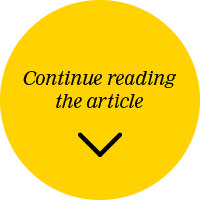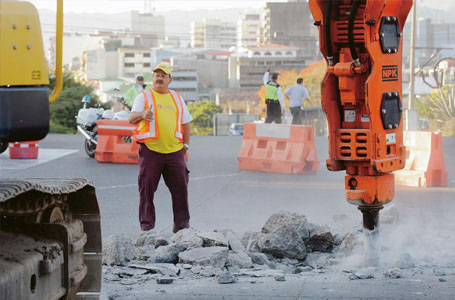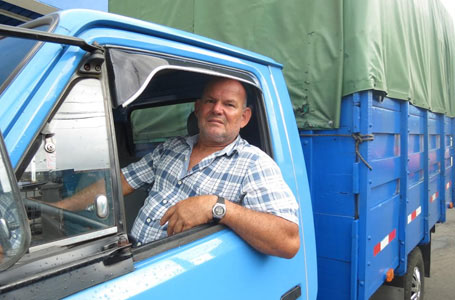-
Hassel Fallas
 hassel.fallas@nacion.com
hassel.fallas@nacion.com -
Mercedes Agüero
 maguero@nacion.com
maguero@nacion.com -
Pablo Robles y Marco Hernández
 infografia@nacion.com
infografia@nacion.com
A
mathematical maneuver made at the end of 2008 by the Public Services Regulatory Body (ARESEP in Spanish) harms, ever since, the consumers of diesel and gasoline, who pay more per liter than do asphalt firms and the consumers of gas who, in turn, save millions because of the lower prices they pay.
From 2009 through September this year, diesel users paid up to ¢73.5 billion more, while gas users save some ¢33.27 billion. Others who benefitted are the firms that buy asphalt and emulsion, which saved at least ¢11.6 billion, at the expense of buyers of regular and super gasoline, who paid an extra ¢29.5 billion.
$45 billion
in subsidy to gas and asphalt equal almost the cost of widening the road from Cañas to Liberia.An investigation by La Nación found that the subsidy to cheapen gas and asphalt (and to increase the price of diesel and gasoline) is hidden in the price formula created by ARESEP in November 2008. That month, with Fernando Herrero as chief regulator, the institution modified the way in which the final price includes the costs of the Costa Rican Petroleum Refinery (RECOPE in Spanish), known as K factor and which are necessary to take to its plants the 15 products it sells.
A cross subsidy is present when a product is assigned a Price higher than the real one in order to lower the price of another product. This happened with the formula to calculate, because even though RECOPE has definite costs to distribute each product (including insurance, shipping, port charges, and inventory, among others), ARESEP calculates them anew based on the import price.
In the last six years, it cost RECOPE an average ¢45 to take every liter of diesel to its plants, but as a result of the financial operation by ARESEP that amount went up to ¢57. As an average, consumers paid ¢12 more per liter. The average final price for diesel (between 2009 and last September) should have been ¢568, not ¢580.
To the contrary, in that period, gas users (most of them industries, businesses, hotels, and restaurants) paid, as an average, ¢27 a liter, ¢24 less than RECOPE’s real cost: ¢51. With no subsidy, the liter would have cost ¢258, but the final price was actually ¢234.
In the case of gasoline, the distribution of one liter of regular meant ¢50 and that of super ¢51; however, ARESEP raised the K for regular to ¢54 and that for super to ¢56. A ¢4 and ¢5 difference, respectively, against the consumer. Buyers paid ¢641 per liter of regular and ¢666 per liter of super.
In turn, the formula favored the price of asphalt. The K factor for that product, in the period discussed, was ¢40 and not the ¢70 required by RECOPE. This enabled industrialists to buy a liter for ¢333 and not for ¢363, as they were supposed to. ARESEP claimed that the change would lower the cost of construction and road maintenance. Also, that it would favor gas for cooking, which is used as a substitute for electricity and firewood.
In order to reach these conclusions, La Nación created a database with information from 59 price resolutions, both ordinary and extraordinary. They were issued by ARESEP in Word and PDF documents, from June 2009 through September this year.

Luis Carlos Solera,
RECOPE’s head of economic and financial analyses
This is the first of six installments in which this daily demonstrates why Costa Ricans buy the most expensive fuel in the Isthmus.
Disclaim. When asked about the issue, former regulator Herrera argued, in an e-mail, that the change in the formula was aimed at making explicit that the prices of fuels came from two sources: their import costs and RECOPE’s costs.
“I think it is not possible to speak about a cross subsidy, because by using a factor (K) in a percentage equal for all of the products, the operation costs are proportionally distributed to the import costs,” Herrero argued.
However, the rate analyst at the regulatory body, Xiomara Garita, asserted that it had always been known that changing the methodology meant creating a subsidy against diesel and gasoline consumers.
“They were decisions from above. The regulator was fully aware of this fact,” added Garita, who had been a member of the team that drafted the report upon which the new formula was based. The public servant claimed that they had acted upon a request by Fernando Herrero and his advisors. “The order is given to the technical team and it just acts,” she remarked.
The subsidy came to be even though, according to the law, ARESEP has to guarantee that no public service company discriminates against a sector or a consumer.
Regarding RECOPE, the change in the estimate of costs does not affect it; it always receives the necessary funds to operate. “The formula does hurt consumers,” admitted Luis Carlos Solera, the refinery’s chief of Economic Analysis, for whom the method “is not crystal clear”. The firm appealed ARESEP’s resolution in all instances, but was not successful.
Until today, the Regulatory Body keeps on applying the same method to establish the prices of fuels. Ingrid Araya, fuel rate coordinator, said last Wednesday that they are analyzing a new method.
Thus was the subsidy born
Before November 2008, ARESEP added a fixed amount (¢58 that year) to the price per liter of fuels in order to cover RECOPE’s costs (K factor). Said method also incorporated a subsidy, since each fuel has a different cost
At the end of that month, the Regulatory Body turned that fixed amount into a percentage. To estimate the percentage, it multiplies the import price of each liter of every fuel by the projection of its yearly sales. The sum resulting from those operations is divided into the income authorized to RECOPE (¢188 billion for this year).
is charged to the final price per liter. That amount differs from the real distribution costs, generating the subsidy. Herrero allowed that distortion when he endorsed, in August 2008, the technical report in which the new formula was proposed. The preceding even though, since his arrival at ARESEP in 2006, he had declared war to subsidies and warned. “We do not create nor reduce them, we just follow the law.”
60% of
the gas
sold by bottlers is used fundamentally by industry, which is followed by hotels, businesses, and restaurants. In the technical report, ARESEP admitted that the formula cheapens the fuels with lower demand and lower international price “now, at the expense of adjusting, to a greater extent, the prices of the more expensive ones in the international market (gasoline and diesel).”
“The change in the method is justified because it would favor road building as a result of the lower impact on the future prices of asphalt and gas,” the document points out.
In April 2008, seven months before the formula became effective, the Chamber of Industry complained because of the high prices of bunker and gas, which are used by its members in production ovens and boilers.
“It would be a pity that now that the free trade agreement with the US was approved and that a negotiation with Europe is under way, we start sending signals of a loss of competitiveness because of the cost of fuels,” stated Martha Castillo, at the time Chamber vice-chairperson, in a letter in which she opposed the adjustment in prices. Castillo chose not to make comments on the issue.
Currently, RECOPE sells 90% of the gas to bottlers and the remaining 10% goes straight from its plants to the industrial sector. Felipe Mejia, Communications manager at Gas Zeta, explained that the larger customers are industries (particularly that of ceramics). Then come businesses, hotels, and restaurants. Jointly, they use close to 60% of the fuel. Another 32% goes to homes and small cafeterias. The remaining 8% is used in cars with adapted engines.
Meanwhile, bunker received subsidies worth ¢4.1 billion in 2013 and so far this year. Before, that product had paid a ¢3.6 billion overcharge.




